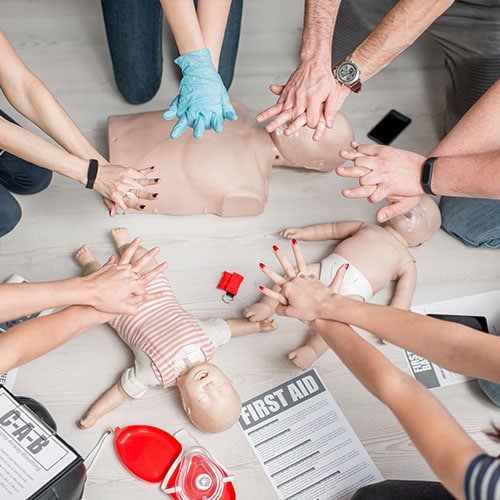Introduction
In our busy world, emergency situations can strike without caution. Whether it's a small injury, a medical emergency, or a life-threatening scenario, recognizing just how to offer emergency treatment can make all the difference. This is where a First Aid course enters play. Many individuals might wonder what they can get from such training, and this short article aims to shed light on that.
By enrolling in a First Help and mouth-to-mouth resuscitation course, you don't simply learn more about wrapping wounds or executing mouth-to-mouth resuscitation; you equip yourself with very useful abilities that could conserve lives. So, what exactly will you discover in a thorough training course? Allow's dive into the details.
First Help Fundamentals: What You'll Learn in a Comprehensive Course
Understanding Very first Aid
What is First Aid?
First aid refers to the first support offered to someone suffering from an injury or disease up until specialist clinical assistance shows up. It encompasses numerous strategies and abilities ranging from simple wound care to lifesaving techniques like mouth-to-mouth resuscitation (Cardiopulmonary Resuscitation).

Importance of Emergency treatment Training
Why Must You Take a First Aid Course?
Taking a First Help course is important for several factors:
- Confidence: Knowing just how to react in emergencies can impart confidence. Life-Saving Skills: The ability to do CPR or help with choking can save lives. Career Improvement: Many occupations call for qualification in first aid. Community Responsibility: Learning means you can aid others effectively.
Overview of CPR
What is CPR?
CPR, or Cardiopulmonary Resuscitation, is an emergency situation treatment executed when a person's heartbeat or breathing has stopped. It integrates breast compressions with rescue breaths to preserve blood flow and oxygenation till specialist aid arrives.

The Structure of a Comprehensive First Aid Course
What Does an Emergency treatment Course Include?
A well-rounded First Aid and mouth-to-mouth resuscitation course typically covers the following topics:
Introduction to First Aid Legal and Ethical Considerations Scene Safety Basic Life Assistance (BLS) CPR Techniques Choking Relief Wound Treatment Management Burn Treatment Managing Shock Recognizing Medical Emergencies Using an Automated External Defibrillator (AED)Legal Facets of First Aid
Are There Legal Effects Involved in Providing First Aid?
Yes, giving first aid does lug lawful responsibilities known as "Do-gooder regulations." These legislations shield people who assist others in emergencies, gave their activities are reasonable and not CPR Course Brisbane reckless.
Scene Security: The Very First Step
How Do You Make sure Scene Safety?
Ensuring scene safety and security includes evaluating the environment before approaching the victim:
- Look for potential risks (website traffic, fire). Make certain it's risk-free for both you and the victim.
Basic Life Assistance (BLS)
What Role Does BLS Play in Emergency Situations?
Basic Life Assistance consists of the fundamentals of keeping life features till further clinical assistance arrives. This area covers essential abilities such as:
- Checking responsiveness Activating emergency solutions Performing high-grade breast compressions
Advanced mouth-to-mouth resuscitation Techniques
What Are Advanced Techniques Covered in Mouth-to-mouth Resuscitation Courses?
Advanced methods might consist of:
- Two-rescuer CPR Use of barrier gadgets for rescue breaths Special considerations for babies and kids
Choking Relief Techniques
How Do You Assist Someone That is Choking?
Choking relief involves 2 crucial techniques:
The Heimlich maneuver for adults. Back blows and upper body thrusts for infants.Wound Care Management
How Do You Properly Take Care Of Wounds?
Effective wound administration entails:
- Cleaning the wound with saline or tidy water. Applying antibiotic ointment. Covering it with clean and sterile dressings.
Burn Treatment
What Work Techniques for Dealing With Burns?
Burn therapy differs by level:
Cool the shed under running water. Cover it with non-stick dressings. Seek clinical interest for extreme cases.Managing Shock
How Is Shock Identified and Treated?
Recognizing shock includes seeking signs like pale skin, rapid pulse, or confusion:
Lay the individual down. Elevate their legs unless there are injuries protecting against this. Keep them calm up until assistance arrives.Recognizing Clinical Emergencies
What Types of Medical Emergencies Need To You Realize Of?
Common medical emergency situations consist of:
- Heart assaults Stroke Severe allergies Comprehending these problems assists you act quickly.
Using an Automated External Defibrillator (AED)
How Do You Utilize an AED Correctly?

Using an AED includes transforming it on, attaching pads according to images on the gadget, and adhering to voice motivates carefully.
Importance of Continual Learning
Why Is Continuous Discovering Important in Emergency Treatment Training?
Continuous understanding ensures you remain updated on ideal practices and brand-new methods in emergency treatment care.
FAQs About First Aid Courses
What Is Consisted of in a Criterion Emergency Treatment Course?- A typical program typically covers fundamental life support, wound administration, choking relief strategies, and lawful considerations.
- Most training courses vary from 6 hours to 16 hours relying on the depth of web content covered.
- Yes, upon successful completion of a lot of programs, individuals receive a first aid certificate, which is generally valid for two years.
- Yes! Many companies provide on the internet training courses that supply adaptable discovering atmospheres while still being effective.
- Absolutely! Hands-on method is essential for understanding abilities like upper body compressions and using AEDs effectively.
- Generally, there are no age limitations; however, participants should be emotionally competent to learn these life-saving skills effectively.
Conclusion
Enrolling in an extensive emergency treatment course furnishes people with vital knowledge that can save lives during emergencies-- whether in your home, job, or out in public spaces! From understanding fundamental life assistance treatments such as mouth-to-mouth resuscitation to discovering exactly how to manage injuries effectively or identify indicators of shock-- these training courses provide important training that anyone can profit from!
As we browse via our day-to-days live loaded with unpredictability-- what far better method than preparing ourselves with expertise gotten from structured training sessions concentrated on conserving lives?
In verdict-- if you're pondering occupying any kind of first-aid training-- never be reluctant! Equip on your own today with these powerful tools since preparedness absolutely makes all the difference when every 2nd counts!